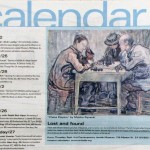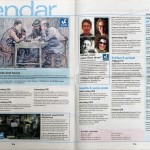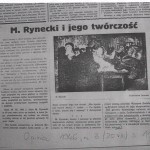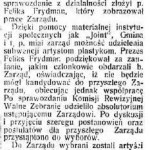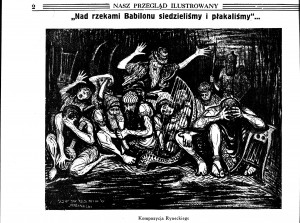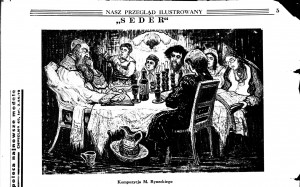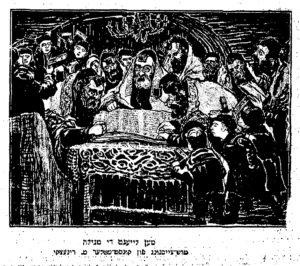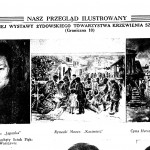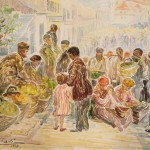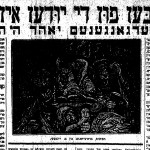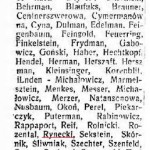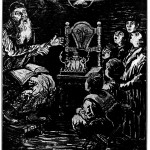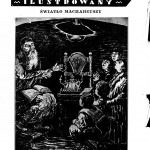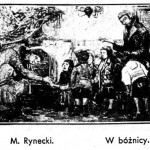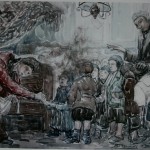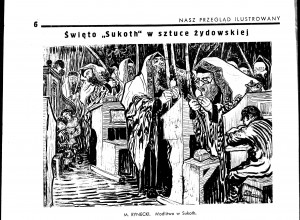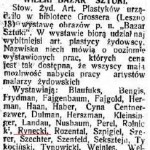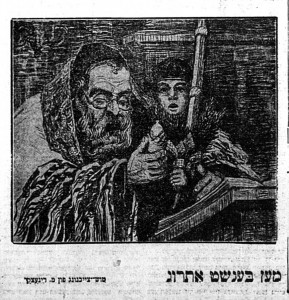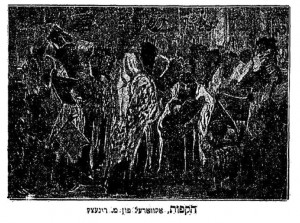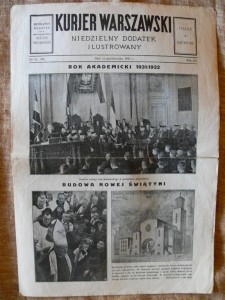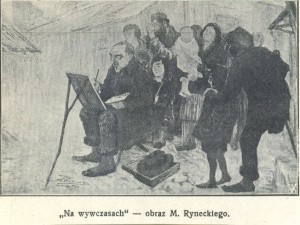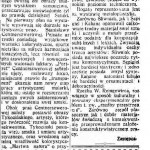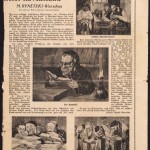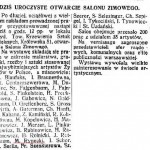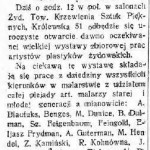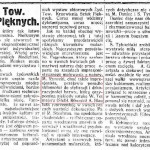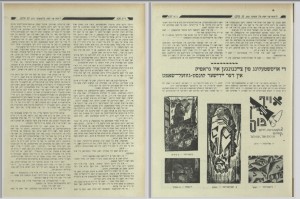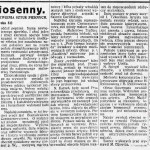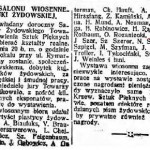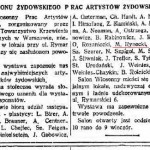2022
Paintings of Torah study that are true works of art – The Forward
2020
OVID.tv Presents CHASING PORTRAITS: A Vibrant Past, Out Of Focus
2019
Poland is Becoming a Global Capital of Jewish Art, Despite Itself – Foreign Policy
Q&A: ‘CHASING PORTRAITS’ BRINGS RYNECKI ’91 FULL CIRCLE, BACK TO BATES
One Man’s Art. One Woman’s Unexpected Path to Healing – Culver City Observer
Jewish Film Festival Run Sept. 15, 22 Lebanon (OR) Express
Chasing Portraits: A Heritage Lost and Found
Chasing Portraits Movie Poster on Adobe Create
Review: ‘Chasing Portraits’ director pursues her great-grandfather’s art lost in Holocaust – LA Times
Jewish Art Lost and Found in ‘Chasing Portraits’ – Jewish Journal
Virtually every movie coming out this summer – Los Angeles Times
Chasing Portraits – Last Day – NYBluePrint
Chasing Portraits: A Website, a Book, and a Film in Search of Heritage – An interview on Submittable
Chasing Portraits – EdgeMedia
‘Chasing Portraits’ Review: The Art of Healing – NonFics
Chasing Portraits’ Review: Seeking Art Lost During the Holocaust – New York Times
The Lilith Watch: Flicks – MavensNest.net
A shadow of the Holocaust hovers over rare, sublime artwork in ‘Chasing Portraits’ -Tallahassee Democrat
Review: Chasing Portraits Is Welcome Personal Testimony, but Its Scope Is Narrow – Slant Magazine
6 Things I Learned Making My First Feature Documentary – First person essay Elizabeth Rynecki wrote for the website: No Film School
Chasing Portraits–Powerful documentary wrestles with cultural repatriation, provides a new vision into losses from war – “Chasing Portraits is a gem of a film for anyone mesmerized by fascinating documentaries and personal journeys of discovery. Thought-provoking and important, it’s your next compelling tale of art, history, and meaning.”
Cinemadope: Rite of Spring – the 14th year of the Pioneer Valley Jewish Film Festival – Valley Advocate
צופן רנצקי – Makor Rishon is an Israeli newspaper that featured an article about Chasing Portraits in March 2019
Eyewitness: Documenting the Holocaust on Film – Jewish Journal
Unseen Films – “This moving portrait of one woman’s effort to connect with her family history and particularly with a man she never knew had me tearing up. The connections she made with her great grandfather across time and space was magical. Highly recommended.”
Dr. Carole’s Couch – VoiceAmerica radio interview
Women filmmakers to be spotlighted during Miami Jewish Film Festival – Sun Sentinel Jewish Journal
2018
A Crusade to Recover Jewish Art Lost During the Holocaust – Haaretz
“Chasing Portraits”: A story of family, legacy and art – The Highland: the voice of Maryville College
Arts About Boston – Radio Story by Penny Schwartz
Free Screening: ‘Chasing Portraits’ Paints a Moving Story – OnLine Athens
6 First Person Docs to See at the 30th Boston Jewish Film Festival – WBUR
SLIFF Spotlight: Chasing Portraits – The Cinema St. Louis Blog. “Undeniably potent. Rynecki thought her ancestor’s artistic legacy to be somewhat obscure…when she eventually learns to her astonishment that not only do numerous other Moshe Rynecki paintings exist, but that they are held in high regard by museums and collectors, the filmmaker finds herself at a strategic and moral crossroads. Should she pursue her great-grandfather’s war-scattered works as a descendent seeking their repatriation? Or should she assume the stance of a historian who merely wishes to bring a neglected artist into the sunlight?”
Four and a half minute Johnson City TV segment
An article in the East Tennessean student paper
Boston Globe Highlighting the Documentaries at this year’s BJFF
St. Louis Jewish Light Family looks for lost art in ‘Chasing Portraits’
A Conversation With ‘Chasing Portraits’ Director Elizabeth Rynecki (Jewish Film Institute on Medium. July 2018)
Searching for Her Great-Grandfather’s Lost Pictures (The Jewish Chronicle. May 2018)
W poszukiwaniu portretów – In Search of Portraits. (Siedlce, Poland newspaper. May 2018.)
2017
CapRadio Reads Interview. November 2017.
Deerfield Public Library Podcast. October 2017.
Q&A with Swenson Book Development. Blog. May 2017.
The Jewish Hour with Rabbi Finman. Radio Interview. May 2017.
Friday Morning Coffee: Chasing Portraits Author Elizabeth Rynecki on Writer’s Bone. Podcast Interview. April 2017.
Chasing Portraits on KERA’s Think. Radio Interview. March 2017.
What to Read on Holocaust Memorial Day (North Coast Journal, January 2017)
On Art, Sex, and Opera (Oakland Magazine, January 2017)
2016
November 2016. Capital Public Radio interview with Beth Ruyak.
Elizabeth Rynecki on Chasing Portraits of pre-Holocaust Jewish Poland (Laurel Zuckerman’s Paris Weblog, October 2016)
September 2016. Book Q&As with Deborah Kalb.
September 2016. How to Unravel an International Family Mystery in Three Not-So-Easy Steps Story by Ian Stewart. San Francisco Magazine.
September 2016. ‘Chasing Portraits’ recounts journey into lost world Robert Nagler Miller , j. correspondent for JWeekly.
August 2016. A ‘Moral Imperative’ to Recover a Lost Art Legacy Eve M. Kahn of the New York Time on the search for my great-grandfather’s art and my new book, CHASING PORTRAITS.
January 2016. Merkel to open Holocaust art exhibit in Berlin The show brought together 100 works on loan from Israel’s Yad Vashem Holocaust memorial by 50 artists created in secret between 1939 and 1945 while they were confined to the camps or ghettos. It included REFUGEES by Moshe Rynecki.
2015
December 2015. Israel’s Nazi Art Hunters This Foreign Policy article includes a brief mention of Moshe Rynecki and the search for his lost art.
Gazeta Fall 2015 [pdf] The Chasing Portraits story appears on page 46. Gazeta is co-produced by the Taube Foundation for Jewish Life & Culture (TFJLC) and the American Association of Polish-Jewish Studies (AAPJS). “For over 20 years, the Gazeta newsletter has reported current affairs and program developments in Polish Jewish scholarship and cultural life. The Taube Foundation is proud to partner with the AAPJS in expanding Gazeta’s reach to a broader audience online.”
November 2015. Przeglad. ODMŁODZIĆ KARSKIEGO (nr 45/2015). The article is a four page interview with film director and producer, Sławomir Grünberg, about his film, Karski & The Lords of Humanity. In the interview he is asked about other projects he is working on and he talks about Chasing Portraits. The article is in Polish.
August 2015. Australian Jewish News. A Search from the Heart.
April/May 2015. Hadassah Magazine. Lost and Found is the Arts feature about the Chasing Portraits project.
1 January 2015, J., the Jewish news weekly of Northern California, placed Dan Pine’s story about the Chasing Portraits project as their cover story: A lost world, on canvas: Oakland woman reclaims her great-grandfather’s legacy
2014
8 September 2014 KHSU’s Through The Eyes of Women aired a radio interview: Brenda Starr Welcomes Filmmaker & Archivist Elizabeth Rynecki Discussing The Quest For Her Great-Grandfather’s Lost Art Legacy From Holocaust Poland.
6 September 2014, Eureka, California’s Times Standard ran the article, Finding Moshe’s Art, about the upcoming Chasing Portraits talk at Temple Beth El.
4 September 2014 Huffington Post, Shadows of the Past and the Winds of War in the Arts & Culture section.
1 September 2014 The San Francisco Chronicle’s Pink Section (Arts and Entertainment) highlighted the “Art Lost: The Search for Moshe Rynecki,” at the San Francisco Contemporary Jewish Museum. The event is sponsored by ArtTable and hosted by the Museum.
25 August 2014 j. the Jewish News Weekly of Northern California picked the upcoming ArtTable talk as their “j. Pick” of the week.
28 April 2014, Museum Minute features my blog on their Meet a Museum Blogger segment.
23 April 2014, Huffington Post features my piece, Jewish Heir Searching for Lost Family Art, in their Arts & Culture section.
18 March 2014, the Omaha World Herald writes about my coming to talk at the University of Nebraska and the Kaneko in: Jewish artist’s great-granddaughter casts herself in ’21st century detective story’ [note: the original link to the Omaha World Herald’s story no longer works, so this link is to the content of the article as it was published by the newspaper.]
2 February 2014, the cover story for The San Francisco Chronicle’s Datebook section, Mystery of ancestor’s lost in Nazi era art haunts woman.
- Rynecki art on cover of Datebook
- Datebook’s Table of Contents
- Two page story spread
27 January 2014, The Times of Israel published Cathryn Prince’s, “The quest for paintings from a lost Jewish world: Elizabeth Rynecki attempts to locate her great-grandfather Moshe’s art, so that while he perished in the Holocaust, his story may live.”
2013
4 November 2013, The University of Toronto’s student newspaper, The Varsity, published Danielle Klein’s piece, “A needle in the stacks: Elizabeth Rynecki discovers her great-grandfather’s lost paintings in the Thomas Fisher Rare Book Library” a story about my visit to Toronto, my talk at the University’s Center for Jewish Studies, and my finds at the library.
In November the British Museums Association Museum Journal published a piece I wrote, “Uncomment: Elizabeth Rynecki on a lost chance.” The piece appears in issue 113/11, p16, 11.2013.
November 2013 the University of Toronto’s Library News adds, “Fisher Library Judaica Specialist Helps Researcher in Quest to Learn about her Great-Grandfather’s Lost Paintings,” an abbreviated version of The Canadian Jewish News story along with some additional links to its UTL newsfeed.
In October The Canadian Jewish News published, “Search for lost pre-WWII art bears fruit in Toronto” The story, written by Fern Smiley, was about my talk at the University of Toronto and the subsequent discovery of materials held by the University of Toronto’s Thomas Fisher Rare Book Library. The online version of the story has only one photograph, whereas the print version had three. You can read the story on my blog to see all the photographs.
In July Keri Douglas of 9 Muses News wrote, “Lost and Found: Moshe Rynecki, Illustrator of Polish Jewish Life.” I’ll let the opening lines speak for the article: “The secrets to the past unfold with gentle whispers guiding the way. How else can one describe the journey of Elizabeth Rynecki in her search for her great grandfather Moshe Rynecki’s illustrations of everyday Jewish life in Poland between the inter-war years and before the Holocaust.”
In May the Jewish Advocate‘s Alexandra Lapkin wrote a Top News story in May titled, “A brush with the Holocaust: Moshe Rynecki lives on through his paintings.” It was a look at the Moshe Rynecki story, art, and Elizabeth’s Thursday June 13th talk for Boston 3G, a group for grandchildren of Holocaust survivors.
The Davis Enterprise had a cover story in April titled, “Holocaust Tale Focuses on Search for Art.” It was about a talk Elizabeth Rynecki (Moshe’s great-granddaughter) gave at Bet Haverim in Davis, CA for Holocaust Remembrance Day.
2006
The Jewish Magazine’s March issue included an excerpt from Surviving Hitler in Poland: One Jew’s Story as well as featuring the painting Forced Labor. The Jewish Magazine is a monthly, online Jewish resource. It features “Jewish articles and Jewish authors on Jewish and Israel topics each month.”
2001
An artist’s virtual museum—Oakland woman links with Polish heritage (Friday November 30th, 2001). Rona Marech of the San Francisco Chronicle wrote a particularly nice article about the Moshe Rynecki virtual museum. Click on the link above to read the article and to view the accompanying photographs.
2000
The magazine, The Jewish Homemaker featured the painting Readers on its June 2000 cover.
The Marin Independent Journal chose the Moshe Rynecki virtual museum as Web of the Week in the winter of 2000.
1999
Joshua Schuster of the The Jewish Bulletin of Northern California wrote a nice piece, “Gen-Xer shows great-grandpa’s Holocaust art on Web” (September 24th, 1999) when our site debuted.
1981
The Independent Journal ran, Art that survived the Holocaust, a front page story about the opening of the Moshe Rynecki exhibition at the Judah L. Magnes museum in Berkeley, CA.
1951
Federation News, Dallas, Texas. June. Center Offers Art Exhibit By Rynecki.
3 June 1951. The Daily Times Herald, Dallas, TX. A photo of a Moshe Rynecki painting and a caption about the Dallas exhibition.
1950(?)
A Texas newspaper ran this photograph of Alex Rynecki (Moshe Rynecki’s grandson) with another Polish immigrant, Nina Ferszt. The title of the photo and the caption: Here’s How Americans Do It.
1949
Friday December 2, 1949. The Denison Press ran a short article on the front page: Displaced Persons of Warsaw First to Reach Denison.
Another article (I’m not sure if it was also The Denison Press) published: Polish Family First Displaced Persons to Settle in Denison. Although less about the Moshe Rynecki art collection and more about the family’s story of survival and arrival in the United States, it is part of the larger family history. Additionally, this is when the collection of paintings in the Rynecki family’s possession arrived in the United States.
1946
Opinia 1946, nr 3 (20 July) pg 10 [Article found by Renata Piątkowska. Translation kindly provided by Yagna Yass-Alston]
On the day of 19th of September 1942, M. Rynecki, in his 57th year of life, is going into his death. And his wife, who miraculously crossed onto the Aryan side, saves from that dangerous situation 70 works of her husband.
There were moments when Rynecki could have saved his life – however he did not want. “I will not leave my brothers – he cried – What will happen to him will happen to me!” and he kept his word.
M. Rynecki, known and acclaimed in the painting circles of the capitol city, he exhibited his works for over 20 years in capitol city’s Zacheta, in IPS (Instytut Propagandy Sztuki/Institute of Propaganda of Art), in the Baryczkow, and lately, before the war, the World’s Fair in Brussel accepted over 60 of his works.
To Rynecki’s style belonged to genre scenes of life of Polish Jews and orthodox labor spheres, and his pictures were fulfill with dynamics and sincerity of representation, filled with extraordinary tints – with succulent/juicy [rich?] colors.
NOTE: The painting featured in this article is held by the Rynecki family.
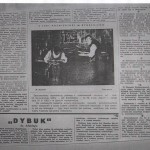 Opinia 1946, nr 10 pg 20 [Article found by Renata Piątkowska.]
Opinia 1946, nr 10 pg 20 [Article found by Renata Piątkowska.]
I do not yet have a translation of this article. Please note that the painting featured in this article was gifted by Perla (Moshe’s wife) to a relative in Israel after the war.
194?
Opinia Nr. 36, page 9. “Posmiertna Wystawa. 57-u- zydowskich art.-plastykow, meczennikow czasow okupacji 1939-1945 r.” by Jozef Sandel. Polish. One paragraph in the final column talks about Moshe Rynecki. I need help translating it. What’s I’ve gathered thus far is this: “Images by Moshe Rynecki. Jewish types, such as weavers, tailors, chess players – wszystikoto (?) Orthodox Jews – workers. among these paintings fascinates blind beggar. Here, looking dreamily lovely Hasidic boy Wilhelm Wachtel. A similar theme has developed graphically Regina Mundlak.”
1939
Walne Zebranie Stow. Zyd. Artystow Plastykow W Polsce [General Meeting. Jewish Artists in Poland]. Note: This article is about elections to the board of directors of the Jewish Society for the Propogation of the Fine Arts. To the audit committee were elected: Welczer-Szweigerowa, M. Rynecki, Z. Herszman, M. Bengis.
1938
Nad brzegami Babilonu siedzieliśmy i płakaliśmy (On the shores of Babylon we sat and wept), 1938; printed in Nasz Przeglad Ilustrowanego 1938, no 32, page 2. The whereabouts of this painting, and whether or not it survived the Second World War, are unknown. A blog post about the find and the full page from Nasz Przeglad Ilustrowanego.
Seder, appeared in at least three publications:
(1) Nasz Przeglad Ilustrowany 1938, number 16, page 5 [titled, “Seder Supper”].
(2) March 1939 in Głos Gminy Żydowskiej (No. 3(21) The Voice of the Jewish Community), a monthly issued by the Warsaw Kehila [titled, “Seder Supper”]
(3) “The Synagogue and The Hazzans’ World” Vol. 3, Warsaw April 1939 [titled, “The Passover Seder according to Halacha”].
The whereabouts of this painting, and whether or not it survived the Second World War, are unknown.
Reading the Megilah, an ink painting. March 17, 1938. Unzer Express, page 5. My blog post about the find.
Kazimierz, 1937, printed in Nasz Przeglad Ilustrowany, 1938 number 9, page 6 (black and white at left included in the newspaper. Color image of the same painting, at right, is held by ZIH (the Jewish Historical Institute in Warsaw)
Unzer Express, September 25, 1938. Tekies / Tekiot, meaning Sounds of the Shofar or Shofar Blasts. Read about the find in my blog post: An ink drawing by M.Rynecki.
Jutro Otwarcie Salonu Dorocznego Z.T.K.S.P [Annual Exhibition of the Jewish Society for the Propogation of Fine Arts Opens Tomorrow]
1937
Naszego Przegladu Ilustrowanego 1937, nr 49. Hanukkah. [note: this painting’s whereabouts are unknown. This reproduction was posted on the cover of Nasz Przeglad Ilustrowany “Our Illustrated Review” 1937, No. 49. These two photographs are different quality images of the same painting. Both are included because one shows the header information about the publication and the other shows a higher quality reproduction of the image] This piece is titled, “Chanuka,” and says below it: composition by M Ryneckiego (a Polish conjugation of Rynecki). The title across the top of the newspaper translates as: “The Light of the Maccabees.” Read my blog post, “A Lost Painting Found in an Old Polish Zionist Newspaper,” to hear a bit about how I found these pieces.
Two paintings included in Nasz Przegląd 1937, No. 38, pp. 6 and No. 39, pp. 5. [note: “w boznicy” means “in the synagogue,” but this title is probably incorrect as the scene does not appear to be inside a synagogue. The image in color at the right appears to be the same as the black and white image. This painting at the right is held by ZIH (the Jewish Historical Institute) in Warsaw. Their records indicate a title of, “Kobiet rozdajaca dary,” which translates to, “a woman handing out gifts.”
Modlitwa w Sukot (Sukkot Prayer) Printed in Nasz Przeglad Ilustrowany, 1937, no 39, page 5
Bazaar of Pictures (20 December 1937, Unzer Ekspres)
Wielki Bazar Sztuki [Grand Bazaar Arts]
Unzer Białystoker Express, year 5, No. 215, September 19, 1937, page 5
Men bensht esreg: tush tseykhnung fun M. Rinetski.
“Blessing the etrog-ink drawing by M. Rynecki.”
[note: Bensht should be bentsht (bless). Perhaps it’s a typo.]
I am told בנשטן is a blessing used after a meal.
Unzer Express from Warsaw, September 26, 1937
Hakafot. Watercolor. It’s so difficult to see this image, but it looks like it is hakafot for Simchat Torah.
1936
Exciting Opening of the Jewish Art Salon in Warsaw (13 December 1936, Haynt)
1933
In 1933, the right wing, Polish-nationalist, and anti-semitic publication, Pod Pręgierzem (Under Pillory?), published a piece titled “Żydzi w Zachęcie” (Jews in Zachęta) which expressed its displeasure with the presentation and exhibition of Jewish artists. My great-grandfather is specifically included in the list of artists which the author of the article named as having been recently displayed at Zacheta.
Thank you to Piotr Nazaruk for the translation:
One of the most important conditions under which Poland can be freed from Jewish influence is total separation of Polish and Jewish art and not exhibiting Jewish art on Polish exhibitions. Whereas Jews are being exhibited as Poles even by institutions with the most beautiful past. Zachęta used to be a center of Polish art in Warsaw. But since a few years, managed poorly, it has fallen lower and lower and turns into a Jewish institution. During the most recent exhibitions one could see works by such artists: Blaufuks Arnold, Mirnsztein Zygmunt, Pułaska-Sperling Helena, Rolnicki Bernard, Rynecki Maurycy, Szaesznajder Leon, Szechler Dawid.
1931
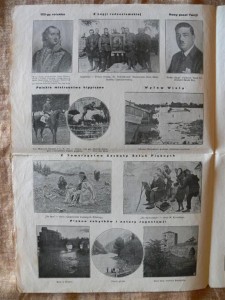
Kurjer Warszawski Niedzielny Dodatek Ilustrowany. [Warsaw Courier Illustrated Sunday Supplement]
This image below is, as you can tell from the two images above, is from the 1931 Warsaw Courier Illustrated Sunday Supplement. The image is on page to the right (the page at the left shows the cover of the newspaper and identifies the paper), it is in the third row from the top, in the right hand column. I originally learned of the image by way of the Iconographic and Photographic at the National Museum in Warsaw which holds this clipping in its collection as Inventory item [inv. DI 59 217].
Salon Doroczny. Zyd Tow. Krzewienia Sztuk Pieknych [Annual Salon. Jewish Promotion of the Fine Arts] A rough translation of the part that talks about Moshe Rynecki, “Representing the naturalism school of painting are R. Mundlak, St. Uzdanski, and M. Rynecki.”
1930
Junge Judische Künstler im Ausland – Young Jewish Artists Abroad [Read translation here]. Published 15 May 1930 in Israelitisches Familienblatt (literally: Israelite Family Paper) illustrated supplemental, issue number 20.
Dzis Uroczyste Otwarcie Salonu Zimowego [Today Opening Ceremony of Winter Salon]
Kronika Zydowska. [The Jewish Chronicle]
Wystawa Zyd. Tow. Krzewienia Sztuk Pieknych [Jewish Exhibition Promotion of the Fine Arts]. Rough translation of information about Moshe Rynecki says, “M. Rynecki, though also an impressionist, has a tendency toward stylization and decorativeness of color, which sometimes resembles art of W. Tetmajer (Ślub/ The Wedding).”
1929
Friday August 9, 1929. Literarishe Bleler. Page 12 (the page with images) contains a Moshe Rynecki painting (bottom left hand corner). This piece is presently held by the Jewish Historical Institute in Warsaw. Here’s a better photograph of it. The title of the piece is: ” a stoler,” which is a carpenter.The text is in Yiddish. Read the translation here.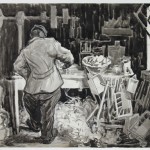
Kurjer Warszawski (4 August 1929, issue no. 211). Jan Kleczynski’s review of the drawings and graphics exhibit at Żydowskie Towarzystwo Krzewienia Sztuk Pięknych [The Jewish Association for the Promotion of Fine Arts]. The works of M.Rynecki are praised for “dobrze zaobserwowane sceny rodzajowe” [well-observed scenes of certain genre].
Great Success of the Exhibit of Drawings and Graphics (25 July 1929, Unzer Ekspres).
The Opening of the Exhibition of Drawings and Graphics (15 July 1929, Unzer Ekspres).
Note: PERHAPS, this catalog posted by Polski Dom Aukcyjny is the catalog for this exhibition written about in the Unzer Ekspres. There are two Maurycy Rynecki items: #272. Przy Chorym, ol. and #273. Modlitwa, rys. There are no photos of the Rynecki work in the catalog, but I am so curious to know if this Modlitwa, is the same as the photo of the painting found in this article Young Jewish Artists Abroad (German language article). No date is included on clipping in my possession.
Salon Wiosenny. Wystawa Zyd. Tow. Krzewienia Sztuk Pieknych [Spring Salon exhibition. Jewish Promotion of the Fine Arts]
1928
Otwarcie Salonu Wiosennego Sztuki Zydowskiej [Opening of the Jewish Art Spring Salon]
Z Salonu Zydowskiego Prac Artystow Zydowskich [From the Jewish Salon. Jewish Artists]

